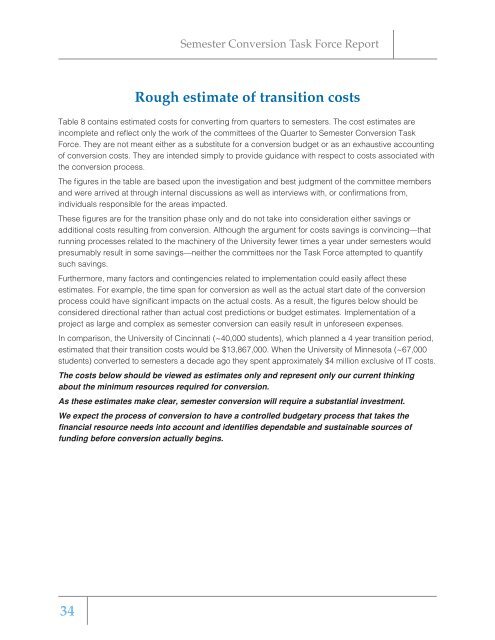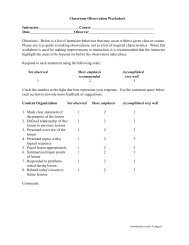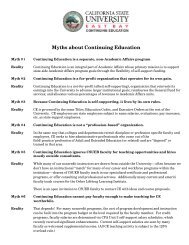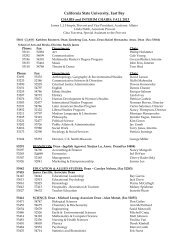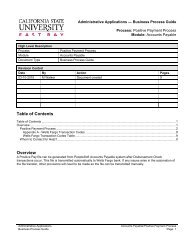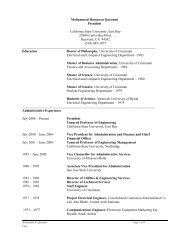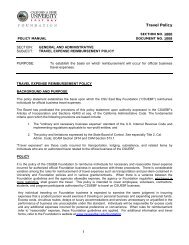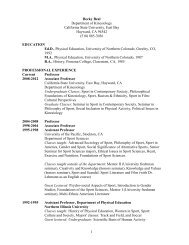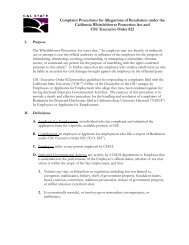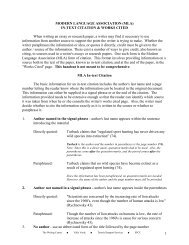Report of the Semester Conversion Task Force - California State ...
Report of the Semester Conversion Task Force - California State ...
Report of the Semester Conversion Task Force - California State ...
- No tags were found...
Create successful ePaper yourself
Turn your PDF publications into a flip-book with our unique Google optimized e-Paper software.
<strong>Semester</strong> <strong>Conversion</strong> <strong>Task</strong> <strong>Force</strong> <strong>Report</strong>Rough estimate <strong>of</strong> transition costsTable 8 contains estimated costs for converting from quarters to semesters. The cost estimates areincomplete and reflect only <strong>the</strong> work <strong>of</strong> <strong>the</strong> committees <strong>of</strong> <strong>the</strong> Quarter to <strong>Semester</strong> <strong>Conversion</strong> <strong>Task</strong><strong>Force</strong>. They are not meant ei<strong>the</strong>r as a substitute for a conversion budget or as an exhaustive accounting<strong>of</strong> conversion costs. They are intended simply to provide guidance with respect to costs associated with<strong>the</strong> conversion process.The figures in <strong>the</strong> table are based upon <strong>the</strong> investigation and best judgment <strong>of</strong> <strong>the</strong> committee membersand were arrived at through internal discussions as well as interviews with, or confirmations from,individuals responsible for <strong>the</strong> areas impacted.These figures are for <strong>the</strong> transition phase only and do not take into consideration ei<strong>the</strong>r savings oradditional costs resulting from conversion. Although <strong>the</strong> argument for costs savings is convincing—thatrunning processes related to <strong>the</strong> machinery <strong>of</strong> <strong>the</strong> University fewer times a year under semesters wouldpresumably result in some savings—nei<strong>the</strong>r <strong>the</strong> committees nor <strong>the</strong> <strong>Task</strong> <strong>Force</strong> attempted to quantifysuch savings.Fur<strong>the</strong>rmore, many factors and contingencies related to implementation could easily affect <strong>the</strong>seestimates. For example, <strong>the</strong> time span for conversion as well as <strong>the</strong> actual start date <strong>of</strong> <strong>the</strong> conversionprocess could have significant impacts on <strong>the</strong> actual costs. As a result, <strong>the</strong> figures below should beconsidered directional ra<strong>the</strong>r than actual cost predictions or budget estimates. Implementation <strong>of</strong> aproject as large and complex as semester conversion can easily result in unforeseen expenses.In comparison, <strong>the</strong> University <strong>of</strong> Cincinnati (~40,000 students), which planned a 4 year transition period,estimated that <strong>the</strong>ir transition costs would be $13,867,000. When <strong>the</strong> University <strong>of</strong> Minnesota (~67,000students) converted to semesters a decade ago <strong>the</strong>y spent approximately $4 million exclusive <strong>of</strong> IT costs.The costs below should be viewed as estimates only and represent only our current thinkingabout <strong>the</strong> minimum resources required for conversion.As <strong>the</strong>se estimates make clear, semester conversion will require a substantial investment.We expect <strong>the</strong> process <strong>of</strong> conversion to have a controlled budgetary process that takes <strong>the</strong>financial resource needs into account and identifies dependable and sustainable sources <strong>of</strong>funding before conversion actually begins.34


